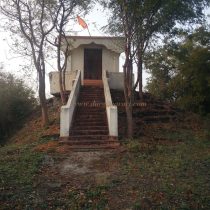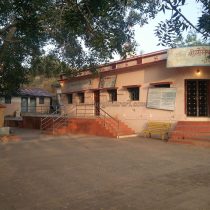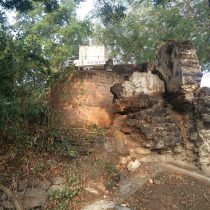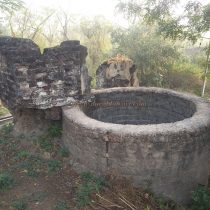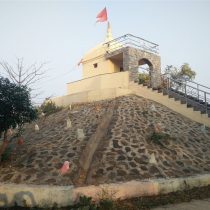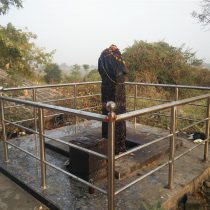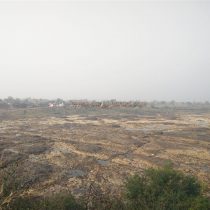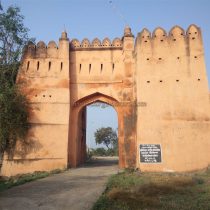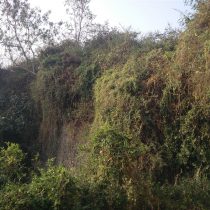JALALKHEDA
TYPE : GROUND FORT
DISTRICT : NAGPUR
HEIGHT : 0
GRADE : EASY
Due to human encroachment on many forts in Maharashtra, the original identity of the fort was erased and today it is known by a new name. the ground fort at Jalalkhed in Nagpur is one of such forts. The original identity of this fort has been erased and today this fort is known as Someshwar Mandir Fort. Today, this place is less popular as a fort and more popular as a temple. The ancient city of Kuntalapur on the banks of Jamb and Annapurna rivers in Nagpur district is today's Katol town. Jalalkhed fort is built at the confluence of Wardha and Jamb rivers in Katol taluka. Nagpur Jalalkheda is 83 km and Katol is 22 km from the city. This fort is situated on the banks of the river outside Jalalkheda village and is now known as Someshwar Mandir Fort.
...
Since the paved road from the village leads to the temple in the fort, we enter the fort directly by private vehicle. This rectangular fort is spread over 25 acres and the majority of the remains of the fort have been destroyed due to the cultivation of cotton and orange orchards in the fort. Wardha and Jamb rivers are present on two sides of the fort and ditches have been dug on the other two sides. The road leading to the fort starts after descending into this moat. Upon entering the fort, the magnificent east-facing entrance of the fort, the adjoining bastion, and the ramparts hidden in the trees attract our attention. In the name of conservation, the entire door has been cemented and painted, which has taken away the original beauty of the door seen before in the brick construction. The sculptures on the door are covered under this cement and a sculpture of Lord Ganesha and some barrage for cannons are somehow retained. Inside the doorway, there are guard porches, and two adjoining bastions are built with two-storied rooms. Upon entering through the door, at some distance on the right side of the road, a collapsed structure can be seen. Three tombs can be seen on the premises of this building. Going straight ahead on the way to the tomb, you can see the ramparts of the fort at the end of the road and the collapsed bastion. After seeing the bastion, come back to the previous path and start exploring the fort. On the left side of the road, a muddy path can be seen entering the trees. Upon entering this path, one can see the tomb of a Sufi saint in a corner of a cotton field. Going back from here, take a straight path and on the left side, you can see the second bastion of the fort and the newly built temple on it. Next to the road is a large lake of the fort which has now been converted into a plain ground. There is a temple of Someshwar Mahadev on this bank of the lake and steps in front of the temple leads to the river. The ramparts of the fort at this place have been destroyed and from here one can descend directly into the river basin. This place should probably have another gate of the fort by the river but as this part is destroyed, no firm statement can be made. From here you can go down to the river basin and see the fort's bastion on the riverside which is still in good condition. Remains of some construction can be seen near the bastion. The road leading straight from Someshwar temple stops at the steps of the citadel on a small hill. The 20-25 steps leading to the citadel are newly built and a well can be seen at the top of the steps. At this place, you can see the arrangement for circulation of the water of the well to the fort. There is a small temple on the citadel and next to it there is a bastion. There is a newly built temple of Lord Shiva on this bastion. Remains of a temple can be seen near the river bastion of the fort. While exploring the fort, you can see a total of 10 bastions, 2 near the gate and 8 in the ramparts. 1 hour is enough to see the entire fort. The fort is believed to have been built in the 4th century during the reign of the Wakataka kings. After the defeat of Devagiri Yadavs, this part came under the Gond dynasty of Devgad, which was a Mughal territory. In 1738, Raghuji Raje Bhosale defeated the Gond kings and established Maratha rule in this area. During this period, the Shiv temple at Jalalkheda was renovated. When Janoji Raje and Mudhoji Raje Bhosale came to this area in 1765, it is mentioned that they stayed at this fort. On January 20, 1769, Madhavrao Peshwa captured the fort and its environs but later handed over the province to Bhosale. In 1820, the fort came under British control.
© Suresh Nimbalkar

